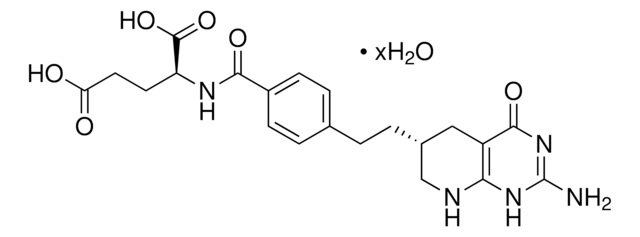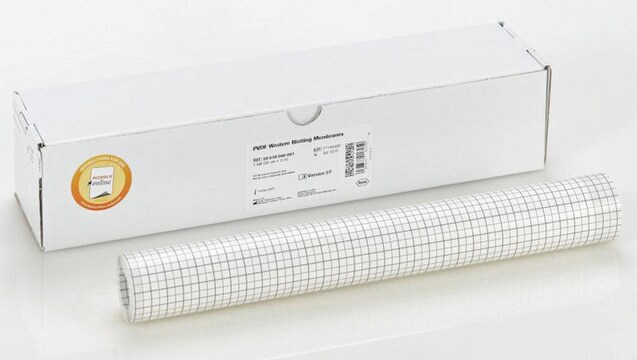S7150
OxyBlot Protein Oxidation Detection Kit
The OxyBlot Protein Oxidation Detection Kit provides the reagents to perform the immunoblot detection of carbonyl groups introduced into proteins by oxidative reactions with ozone or oxides of nitrogen or by metal catalyzed oxidation.
Synonym(s):
OxyBlot assay, Protein oxidation kit
Sign Into View Organizational & Contract Pricing
All Photos(1)
About This Item
UNSPSC Code:
12161503
eCl@ss:
32161000
NACRES:
NA.84
Recommended Products
Quality Level
manufacturer/tradename
Chemicon®
OxyBlot
technique(s)
western blot: suitable
detection method
chemiluminescent
shipped in
wet ice
General description
Oxidative modification of proteins by oxygen free radicals and other reactive species occurs in physiologic and pathologic processes. As a consequence of the modification, carbonyl groups are introduced into protein side chains by a site-specific mechanism. The OxyBlot Kit provides reagents for simple and sensitive immunodetection of these carbonyl groups, which is a hallmark of the oxidation status of proteins.
Application
Preparation of Cell Lysate
1. Wash adherent cells twice in the dish or flask with ice-cold PBS and drain off PBS. Wash non-adherent cells in PBS and centrifuge at 800 to 1000 rpm in a table-top centrifuge for 5 minutes to pellet the cells.
2. Add ice-cold RIPA buffer to cells (1 ml per 107 cells/100 mm dish/150 cm2 flask; 0.5 ml per 5 x 106 cells/60 mm dish/75 cm2 flask).
3. Scrape adherent cells off the dish or flask with either a rubber policeman or a plastic cell scraper that has been cooled in ice-cold distilled water. Transfer the cell suspension into a centrifuge tube. Gently rock the suspension on either a rocker or an orbital shaker in the cold room for 15 minutes to lyse cells.
4. Centrifuge the lysate at 14,000 x g in a precooled centrifuge for 15 minutes. Immediately transfer the supernatant to a fresh centrifuge tube and discard the pellet.
5. Dilute the cell lysate at least 1 : 10 before determining the protein concentration because of the interference of the detergents in the lysis buffer with the Coomassie-based reagent. At this step, the sample can be divided into aliquots and stored at -20¡C for up to a month.
TIP: When working with large volumes of non-adherent cells, the cells may not be cooled quickly enough to maintain the activity of the protein being studied. In this case, pour the cell suspension into a mixture of an equal mass of 2 x PBS and ice, then collect the cells by centrifugation and perform the lysis as described above.
RIPA lysis buffer:
Catalog number 20-188
http://www.millipore.com/catalogue/item/20-188
Reducing agent is very important for preventing oxidation:
The protein lysate may be prepared using a variety of protocols. Most standard buffers such as RIPA and Triton are also suitable. It is recommended that a reducing agent be added to the lysis buffer to prevent the oxidation of proteins that may occur after cell lysis. Lysis buffer containing either 1-2% 2-mercaptoethanol or 50 mM DTT sufficiently inhibits this oxidation, but has no adverse effect on the derivatization reaction in the OxyBlot protocol. Purified protein samples are also suitable for analysis with the OxyBlot Kit.
For general information about protein extraction, please check this link.
http://www.millipore.com/immunodetection/id3/proteinextraction
1. Wash adherent cells twice in the dish or flask with ice-cold PBS and drain off PBS. Wash non-adherent cells in PBS and centrifuge at 800 to 1000 rpm in a table-top centrifuge for 5 minutes to pellet the cells.
2. Add ice-cold RIPA buffer to cells (1 ml per 107 cells/100 mm dish/150 cm2 flask; 0.5 ml per 5 x 106 cells/60 mm dish/75 cm2 flask).
3. Scrape adherent cells off the dish or flask with either a rubber policeman or a plastic cell scraper that has been cooled in ice-cold distilled water. Transfer the cell suspension into a centrifuge tube. Gently rock the suspension on either a rocker or an orbital shaker in the cold room for 15 minutes to lyse cells.
4. Centrifuge the lysate at 14,000 x g in a precooled centrifuge for 15 minutes. Immediately transfer the supernatant to a fresh centrifuge tube and discard the pellet.
5. Dilute the cell lysate at least 1 : 10 before determining the protein concentration because of the interference of the detergents in the lysis buffer with the Coomassie-based reagent. At this step, the sample can be divided into aliquots and stored at -20¡C for up to a month.
TIP: When working with large volumes of non-adherent cells, the cells may not be cooled quickly enough to maintain the activity of the protein being studied. In this case, pour the cell suspension into a mixture of an equal mass of 2 x PBS and ice, then collect the cells by centrifugation and perform the lysis as described above.
RIPA lysis buffer:
Catalog number 20-188
http://www.millipore.com/catalogue/item/20-188
Reducing agent is very important for preventing oxidation:
The protein lysate may be prepared using a variety of protocols. Most standard buffers such as RIPA and Triton are also suitable. It is recommended that a reducing agent be added to the lysis buffer to prevent the oxidation of proteins that may occur after cell lysis. Lysis buffer containing either 1-2% 2-mercaptoethanol or 50 mM DTT sufficiently inhibits this oxidation, but has no adverse effect on the derivatization reaction in the OxyBlot protocol. Purified protein samples are also suitable for analysis with the OxyBlot Kit.
For general information about protein extraction, please check this link.
http://www.millipore.com/immunodetection/id3/proteinextraction
Storage and Stability
Store the protein standard (component 90450) at -25° to -15°C upon receipt. Store all other components at 2°C to 8°C.
Legal Information
CHEMICON is a registered trademark of Merck KGaA, Darmstadt, Germany
Disclaimer
Unless otherwise stated in our catalog or other company documentation accompanying the product(s), our products are intended for research use only and are not to be used for any other purpose, which includes but is not limited to, unauthorized commercial uses, in vitro diagnostic uses, ex vivo or in vivo therapeutic uses or any type of consumption or application to humans or animals.
Signal Word
Warning
Hazard Statements
Precautionary Statements
Hazard Classifications
Met. Corr. 1 - Skin Sens. 1
Storage Class Code
8A - Combustible corrosive hazardous materials
Certificates of Analysis (COA)
Search for Certificates of Analysis (COA) by entering the products Lot/Batch Number. Lot and Batch Numbers can be found on a product’s label following the words ‘Lot’ or ‘Batch’.
Already Own This Product?
Find documentation for the products that you have recently purchased in the Document Library.
Bone Marrow Cells Reduce Fibrogenesis and Enhance Regeneration in Fibrotic Rat Liver.
Sun CK, Chen CH, Kao YH, Yuen CM, Sheu JJ, Lee FY, Chen YT, Kung CT, Yip HK
The Journal of Surgical Research null
Oxidative stress, induced by 6-hydroxydopamine, reduces proteasome activities in PC12 cells: implications for the pathogenesis of Parkinson's disease
Elkon, H. et al.
Journal of Molecular Neuroscience, 24(3), 387-400 (2004)
Mitochondrial complex I activity and oxidative damage to mitochondrial proteins in the prefrontal cortex of patients with bipolar disorder.
Andreazza AC, Shao L, Wang JF, Young LT
Archives of General Psychiatry null
Specific inactivation of cysteine protease-type cathepsin by singlet oxygen generated from naphthalene endoperoxides.
Nagaoka, Yuki, et al.
Biochemical and biophysical research communications, 331, 215-223 (2005)
Ketone bodies stimulate chaperone-mediated autophagy.
Finn, Patrick F and Dice, J Fred
The Journal of Biological Chemistry, 280, 25864-25870 (2005)
Our team of scientists has experience in all areas of research including Life Science, Material Science, Chemical Synthesis, Chromatography, Analytical and many others.
Contact Technical Service







